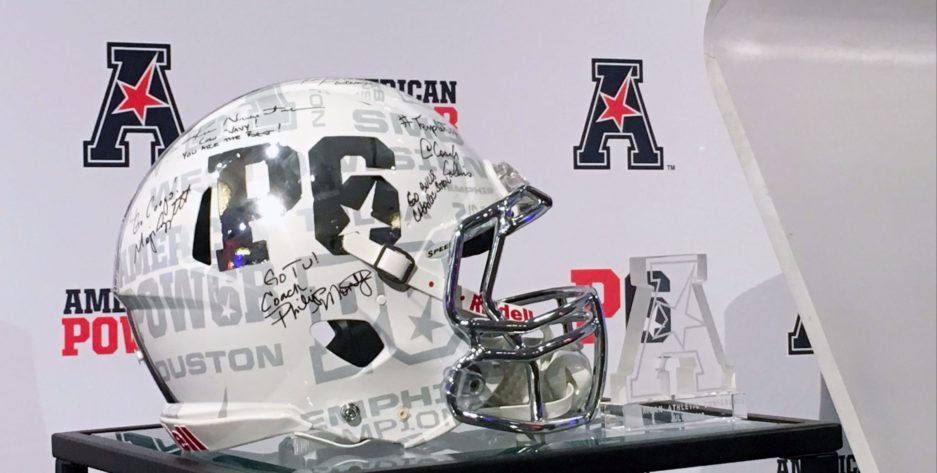The AAC championship game takes place on Saturday, in a rematch between the same two teams who played a double OT thriller last season.
It is also a rematch of UCF’s closest game this season and in their 24 game winning streak.
To be honest, UCF should have lost at Memphis earlier this season and I think Mike Norvell struggled with his play calling due to the heavy rain which evidently let UCF hang around way longer then they should’ve.
I won’t go into that, however, there is one major difference this week, a Darriel Mack will be playing QB for UCF after McKenzie Milton suffered a devastating injury last week. I’m going to break down Memphis offense vs. UCF defense here, but if you want to see my take on the UCF offense with Mack at the helm, it should be the previous blog.
So, to me, there’s 4 things that I’ve come across after charting every UCF defensive play from this season that are quote on quote weaknesses based on their performance in other areas.
Two have to deal with the run, and two with the pass. I’ve mentioned them all before, but this week, it’s different because Memphis has been pretty good at doing what UCF has been bad at stopping and without Milton playing, the offense is a major question mark this week.
Personnel:
Throughout a 10 (fbs) game season, UCF has faced just about every personnel possible, some more than others of course.

You can get a pretty good idea of how solid on a play for play basis, the defense has been based on the low success rates against “11” personnel which is what they’ve faced on almost 60% of plays this season.
The next, “12” personnel. This is my first point. Against “12” personnel they’ve faced a 73% run rate and have allowed a 54.32% success rate. Their highest allowed success rate against both the run and pass in either that they’ve faced a relatively decent sample size.
Everyone knows Memphis is a great running team. Henderson, Pollard, and Taylor is a three headed attack and Henderson has been the best running back in the country this season.

“12” personnel is their second favorite personnel to run out of and their best personnel to run out of, if you only include their personnel’s that have over 50 rush attempts.
If you remember the first match-up between these two teams, you know Memphis scored all 30 of their points in the 1h.
Interestingly enough, they ran 19 plays out of “12” personnel and in the 2h they only ran 2 despite going extremely run heavy.
Why do I think they are so good out of “12” personnel?
Well Magnifico and Dykes (Memphis TE’s) are both solid blockers, but they can only split out as they are great receivers. They can have both tight, both split, or one tight and one split. With a split TE it forces a LB out of the box and with them both tight, it just adds extra blocking.
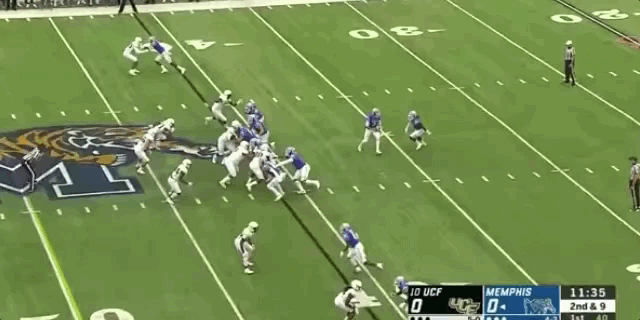
Both tight ends are tight here, simple run to the left end (something I’ll talk about next) and it goes for 17 yards.
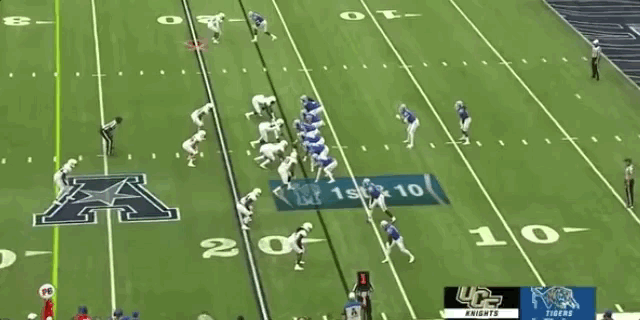
The longest run of the game and 2nd longest UCF has allowed all season. Dykes splits out and forces Evans to cover him in the slot, taking him out of the box. This forces Causey into the LILB position because Dykes is too big of a matchup for him, and Causey gets destroyed in the second level by a lineman.
Now, I’ll be honest, Memphis wasn’t the best out of “12” personnel in their first meeting, but it is still baffling to me that they went completely away from it in the 2h because “21” personnel wasn’t working.
Rushes to the Left End:
Both of the above rushes fit this perfectly as well. Memphis loves to run to the outside.
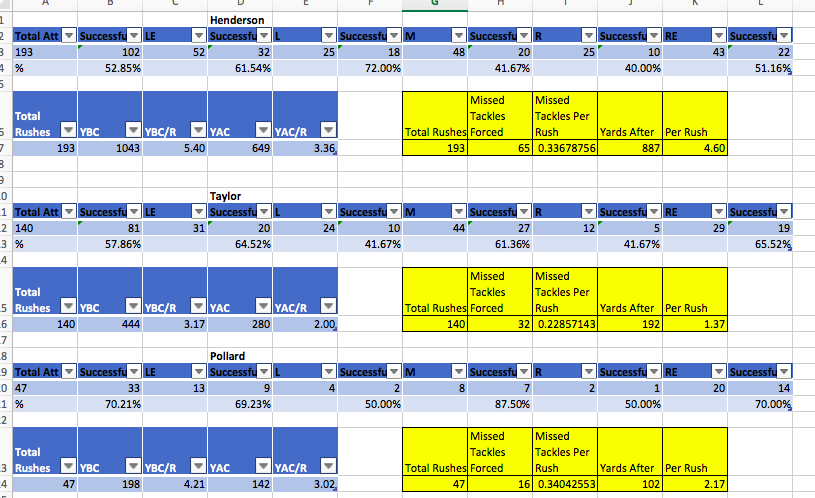
Both Henderson and Taylor’s favorite direction to go. On a combined 83 rushes, they’ve been successful 52 times, I’m not good at math, but that is a very high %. If you throw in Pollard, they are 61 for 96.
Tony Pollard is a running back on the roster and I chart him as one, but he also lines up in the slot a ton and is almost always in with another running back. 34 of his 47 carries have come with 2 RB’s on the field.
Norvell uses him how Heupel should use Otis Anderson, but that’s a different discussion for a different day.

If you look at where UCF has struggled against the run, look no further than to the LE. Their overall success rate against is 48.15% which is respectable, especially considering the running backs they’ve faced, but to the left end they’ve allowed a 58.46% success rate on 65 rush attempts.
Now, Memphis isn’t going to just run the ball to the left end out of “12” personnel every single play, but they should do it more frequently then they would in a normal game.
Memphis also has an explosive run (10+ yards) on 21.52% of their carries, while UCF lets one up 17.41% of the time.
The above gifs fit perfectly into everything in here, left end rushes, “12” personnel, and explosive runs.
Middle of the field Passing:
This is an area, I’ve been mentioning for a while. UCF’s corners are great. Nevelle Clarke and Brandon Moore I’ll take against any outside receivers in the AAC and Rashard Causey has been dominant against the slot of late.
Where this pass defense has struggled is when guys get passed onto LB’s or safeties and when they get stuck in man coverage.
All of this occurs on plays between the numbers.

UCF has actually gotten a little better in the last two games here, if you remember the chart before the Cincinnati game it was a little uglier.
Between the hashes, it is still very ugly. On 53 targets, they’ve allowed a 60.38% success rate and a 77.36% catch rate.
The next two highest catch rates they’ve allowed? To the right and left. Now, the success rates are a little lower, but opponents have missed a combined 14 plays due to either inaccurate passes or drops.
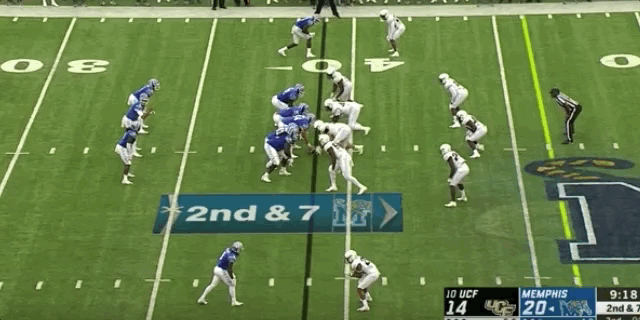
Now, there is a lot more wrong with this play than just the pass over the middle, Titus should’ve had an easy sack, but you’ll see Moore open up a little because Gibson has him over the middle, except Gibson tries to jump the route and completely whiffs allowing a huge gain.

Memphis’ passing success lives to the left and right directions. Now, the middle, is by far their worst area in the passing game, but on 51 targets, they’ve had 8 drops on White has missed an open receiver 4 times. That’s a significant amount and if even half of those are turned into successful plays, their success rate jumps over 50%.
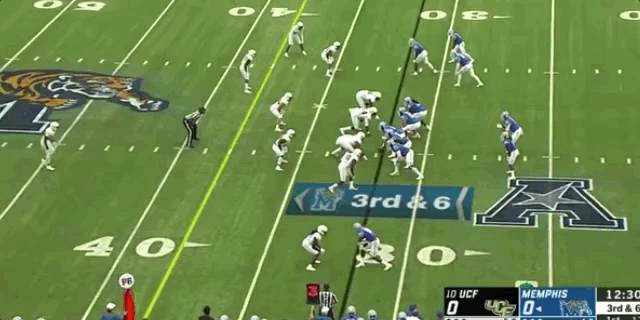
A 3rd and 6 here, Clarke sees Henderson running a wheel route out of the backfield and passes off his guy to the middle, but no one picks him up. It’s been a routine thing for UCF this season.
I could show probably a good 45-50 plays just like this from this season.
It is really just a question of whether an offense is smart enough to run these concepts over and over again and no one has yet, but Memphis is probably the most fit to face this UCF defense.
Play Action:
Almost every offense is better with play action and with that said, every defense is worse against play action so this isn’t ground breaking here, but it’s worth pointing out. With Milton at QB, UCF used PA over 50%, I don’t think many teams will come close to that, but Memphis is a lot closer to 50/50 than Cincinnati was and they’re still not even close.

Brady White is a major question mark at QB, so when you see his PA numbers they kind of jump out at you. a 65.77% completion percentage with an aDot of 10.51 is pretty damn good. a 9.82 ypa and a near 60% success rate are also incredible.
When you jump to non-play action, the aDot dips significantly and his YPA drops over a yard and a half. His accuracy improves slightly, but his completion percentage drops a lot and the success rate drops almost 15%.
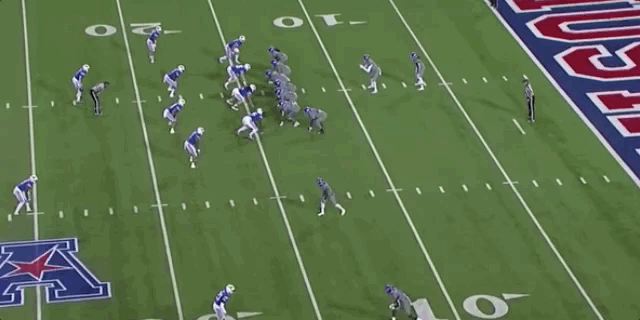
A great time for play action? 1st and 10. Memphis has attempted 61 passes on 1st and 10 in the 1h and 41 of them have been successful.
“12” personnel and 8 in the box here, this is what can happen when you play the run.
Memphis only ran 6 play action passes against UCF, 4 of them were successful.
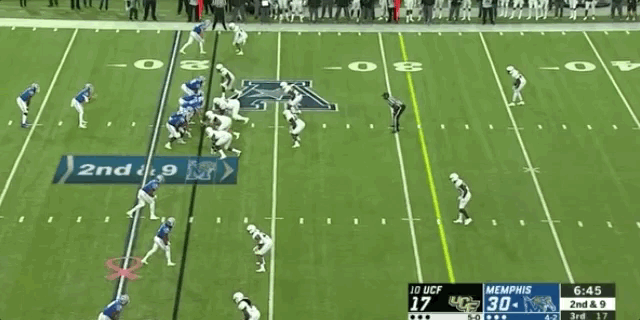

UCF’s numbers aren’t drastically different, but there is an advantage here and one that Memphis should try and take advantage of.
Also, the amount of play action passes against UCF this season has been staggeringly low.
Play Calling:
As always, I tried to look at some sort of play calling trend with the opposing team.
This week, I looked at 2nd down play calling based on what happened on first down. There were 5 different options.
This plays only include 1st and 10 plays that were followed by a second down play that didn’t have a penalty before it. They are also only from the 1h as in the 2h play calling can become time and score based and if not, I would assume the same trends.
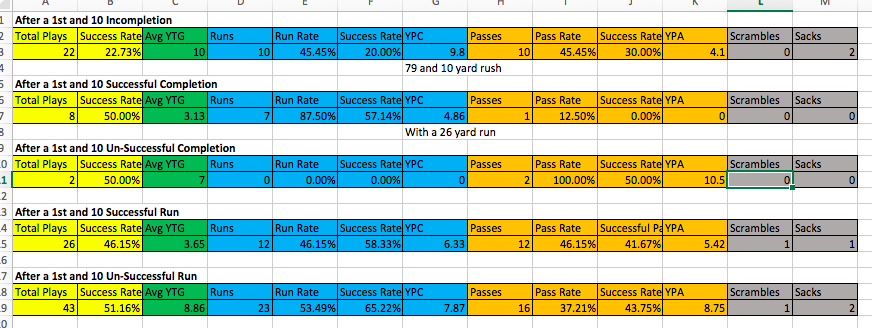
I mentioned how good Memphis was on 1st and 10 passing, but when they throw an incompletion, they are very bad on second down. A common play calling trend in the 2nd down run after a 1st and incompletion. Norvell does this about 50% of the time (decently high) despite having no success with it. Outside of two explosive runs, this has been a wasted down.
Interestingly, after an unsuccessful 1st and 10 run, so it’s 2nd down and at least 7, Memphis runs the ball 54% of the time on 2nd down and have a 65.22% success rate doing so.
They don’t like to throw the ball 2 plays in a run when it’s on first and then second down.
Overall:
UCF is still the better team in this game, but the better team doesn’t always win. Matchups matter so much in sports and I just happen to think Memphis’ offense matches up well against UCF’s defense. I’m not saying they’re going to win or that they will do any of the things above, but they’ve done them throughout the season and if Mike Norvell was smart, he’d continue to roll with the above.
It should be a very close game Saturday and I am extremely interested to see how it plays out. Before the Cincinnati game I was confident it wouldn’t be close, because Cincinnati’s offense didn’t attack UCF’s weaknesses, Memphis does, so it should be close.
